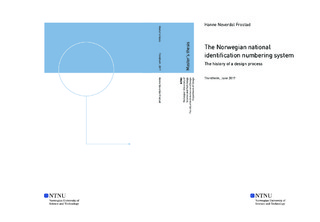| dc.description.abstract | The Norwegian national identification numbering system, introduced in the 1960s, is an important tool used in all parts of public administration in Norway today. By serving as a means for identifying people, the numbering system makes administrative work and communication between public agencies and individuals more effective. The country s residents are listed in a central population register and assigned unique identification numbers. The numbers function as labels for the bundles of information tied to individuals registered in an information system. The Norwegian word for the number is fødselsnummeret (literally, the birth number ). It is such an integral part of everyday life in Norway that most people take it for granted and think of its design as a given, naturally discerned from the information it represents.
This master s thesis examines the history of the national identification numbering system in order to understand the design process behind it. It turns out that the design and implementation of the numbering system was influenced by a wide range of factors, including technology, law, and user needs. In a proposed redesign of the system presented to the Norwegian parliament in March 2017 the balance of the various influencing factors has shifted and an emphasis on user needs and a user-centered approach to design has emerged. | |

